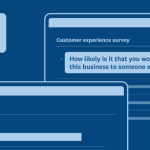Building a startup is like sprinting a marathon. But if you can pull it off, the payoff is immeasurable. Along the way, surveys can help. Here are 5 thought-starters to help you unlock startup growth through powerful survey feedback.
1. Understand (and prove!) your addressable market.
When it comes to raising venture capital, numbers speak louder than words. But numbers aren’t always easy to come by early on when impressive success metrics are still a few funding rounds away. Surveys can provide powerful validation that your addressable market represents a compelling opportunity.
“When I’m backing an entrepreneur, one of the things that I’m looking for is unique market knowledge that no one else has access to,” explains Zoe Schlag, managing director at the highly respected accelerator Techstars Impact.
One of the entrepreneurs that caught Zoe’s attention? Jamee Herbert, founder of BridgeCare Finance, a startup that provides employer programs which give parents more flexible and innovative ways to pay for childcare.
Like many startups, Jamee’s company couldn’t point to a precedent to justify the market demand, because she was trying something new. And innovation comes with risk. So what did she give investors to put their minds at ease? Survey data.

Here’s how to use surveys from early on to establish your market, according to investors from Draper Associates, 500 Startups, and TechStars:
- Confirm that the problem you’re solving really exists: Jamee asked parents about how much they were paying for childcare, how they were paying, and how childcare costs affected mothers’ ability to work.
- Purchase intent and frequency: Would people be truly interested in buying a product like yours? If so, how often?
- Willingness to pay: Early survey research gives investors a reasonable benchmark for the cost of your product or service that consumers would accept. You can also combine this information with their purchase intent response and start to calculate potential revenue from there, depending on the size of the population.
- Demographics: Adding demographics questions to market research surveys can provide insight into whether different groups have different responses to your potential offerings, and whether there’s a niche that you can own. Gender, age, geographical location, and occupation can all provide key strategy indicators and help you identify your ideal customer.

Surveys can give you leverageable data fairly quickly. Jamee sent a survey to a nationally representative sample of parents with children under 5 using SurveyMonkey Audience. Within 24 hours, she had enough information about childcare costs to win $20K in funding in a pitching competition, which led to further investment and acceptance into the TechStars Impact accelerator.
Get started now: Create a survey that touches on each of the bullets above, and tailor it to your niche. Use SurveyMonkey Audience to reach a panel of objective respondents, and adjust the targeting parameters to ensure that you reach the most relevant group possible.
As you scale: Keep tracking how the market changes. You’ll be able to show progress to investors, identify market opportunities, and lay the foundation for future rounds of funding. SurveyMonkey Enterprise also lets you benchmark a variety of factors against other companies so you can see how you stack up.
Ready to prove your product-market fit?
SurveyMonkey Audience can get you the representative sample you need to showcase your potential.
2. Test your ideas early and often.
Do people care more about complex capabilities or usability? Is there demand for that fancy feature you’ve been thinking about investing resources in? Which packaging sits best with your chosen audience?
To answer questions like these, try concept testing with your early customers, or with a random sample of your target market. Here are some ways that you can use concept testing, with links to survey templates to get you started:
- Choose a brand or product name: find something that resonates with consumers, and gets your meaning across.
- Test different logos: Find something that differentiates your startup and stands out.
- A/B test your ads to see which ones are worth investing in.
- Figure out how people will respond to different product ideas before you got to market.
- Experiment with different types of marketing claims and messaging to see what sticks.

Masterful concept testing can help you avoid costly mistakes in the lean years when you’re launching your company. The survey templates above can get you started, and if you’re building your own program from scratch, we have an in-depth concept testing guide that walks you through every step.
Sometimes, a little change can mean a major step forward. RxBar famously attributes its success to redesigned packaging. The company’s revenue jumped from $6M in 2014 to $130M in 2017. Don’t be afraid to ask about the details, and get as many opinions as possible.
When you’ve found something that you think works, test it again. The more often you survey, the more clearly you’ll be able to benchmark against your previous results.
Get started now: Prioritize the branding decisions that will give your startup its company identity. Company name, logo, and product names could all have dramatic impact. Read through our concept testing guide to learn about the factors you can test for.
As you scale: Make feedback gathering a cross-functional effort between product, marketing, customer success and sales, so that you’re collaborating to find new growth opportunities. SurveyMonkey accounts for Teams enable different groups in your org to collaborate, comment, and iterate until you have a survey that satisfies all parties.
Ready to collaborate & test your ideas?
Teams enables your product, sales, marketing team and anyone else to build surveys that meet everyone’s needs.
3. Create an employee feedback program that scales with your business.
Tech startups of 100 people or fewer have half as many HR employees as similarly sized companies in other industries. (And many have the cultural and retention problems to show for it.) It may seem ridiculous to ask employees for feedback when your business is only five people in a room, but the reality is that the programs you put in place early on set the tone for the kind of employer you ultimately become.
Surveys give employees an opportunity to voice concerns that they might otherwise have repressed (or even quit over) and surface positive ideas that could help you attract and retain more talent. Feedback programs also give employees the chance to feel heard, which can have a surprisingly powerful effect, even when it doesn’t result in a solution.
Putting feedback surveys in place and acting on what you learn from them can reduce attrition and improve the quality of life for your earliest—and most critical—hires. It also clearly illustrates your organization’s commitment to focusing on employee experience as it grows. Finally, the feedback that you get through employee surveys could give you the input you need to win over potential new recruits.

Feedback surveys should be brief, painless, and delivered at a regular cadence so that you can track changes over time. We recommend a short, sweet and mobile-friendly pulse survey once a month that focuses on a different aspect of engagement.
When planning your survey programs, think about the employer that you want to be. If your company had 5,000 employees instead of 15, what would you want to have perfected? That’s what you should be laying the groundwork for right now.
Here are some survey templates to help you launch the most critical employee feedback programs:
Get started now: Start by identifying your HR goals and work backward. Are you worried about creating a positive recruiting experience? Giving employees constructive performance feedback? Building an inclusive culture? SurveyMonkey has a variety of templates that can help you out. Our comprehensive playbook for using surveys in HR explains how to use them.
As you scale: Explore SurveyMonkey Engage so that you’re asking the right questions and automating the administrative work as you scale.
4. Create in-demand content and press interest early on.
Competing for attention when you’re just starting out can be...disheartening. Unless you have a big-name investor backing you up or a founder with some (business) street cred, you’re likely to be ignored regardless of how cool your product is. One way around that? Unique data.
Asking the right questions can make you newsworthy long before you’re a household name. Brianna Miller, a content strategist at the work management software company Wrike, decided to conduct a survey that asked people about their workplace swearing habits. She used SurveyMonkey Audience to reach the right people quickly, wrote up the results, and ended up with over 100 press mentions including The Washington Post, Fortune, Fast Company, and TV coverage on NBC.
Tips for creating viral content from surveys:
- Find a topic that specifically appeals to your audience, answers questions that haven’t been asked before, or takes a unique angle on a hot topic.
- Ask controversial questions.
- Give respondents a blank text box so that you can capture quotes and soundbites that will make for strong headlines.
- Include demographic questions so that you can pick up on differences between different groups and noteworthy trends.
- Consider sending the same survey over the course of the year so you can see if attitudes change over time and if major world or industry events impact your responses.
- Collaborate with influencers and/or quote them in your content, so that they’ll be likely to share your findings with their network. If you didn’t work with them directly, make sure to let them know you’re including them. Even a quick tweet can make a big difference. As Andy Crestodina, co-founder and CMO of Orbit Media Studios preaches, “A partner in content creation is a partner in content promotion!”
You can find rules for planning your survey, assessing risks, designing a survey scientifically and strategies for analyzing your findings in the ultimate guide to using surveys for content marketing.
Get started now: Create a survey that asks the questions you’re interested in. With SurveyMonkey, you can share your survey through a link, send via email, target our global Audience panel, or generate a QR code. Trade shows and events are a great place to collect responses—just make sure that you have our offline capabilities enabled.
As you scale: Find unique ways to differentiate your company’s marketing content and find a fit in the market. You can get insights from award-winning marketers from The Clorox Company, Duke’s Fuqua School of Business, and IfOnly in our recent webinar, “How to avoid bland marketing: The risk-taker’s guide to campaigns that stand out.”
5. Get insights and validation from your earliest customers.
Sometimes, your customers are your best salespeople. Other times, they might even be your best strategic advisors. Here’s a real-life example:
Jer Langhans is the co-founder of Paired Sourcing, a company that helps businesses craft perfectly tailored talent pipelines before hiring sprints. Paired Sourcing is relatively young, founded just over three years ago, but already has a devoted base of returning customers. Jer was curious to know more about exactly what kept customers coming back and what else might be valuable to them, so he created and sent a Net Promoter Score (NPS)®* survey.
NPS surveys are the industry standard for a reason. They’re the best, most objective way to measure customer loyalty and marketing momentum. But NPS® can also do more than give you a marketing report card—it can yield important insights about your product and your business.
When the responses came in, Jer learned that his customers were happy with their service, but he also learned that some were interested in a subscription service (rather than having to re-engage with the company every time). “As well as I thought I knew my customers, I would never have arrived at that business insight without the survey,” says Jer, who successfully launched a new subscription option for Paired Sourcing as a result.

Customers are your best advocates and your best “feet on the ground” when it comes to building out a new product. To run your own assessment, start by using our pre-designed NPS® survey template (the same one Jer and his team used.) Those open-ended questions at the beginning are where you’ll find your specific, action-oriented bits of customer wisdom.
When you get the results back, use our free NPS® calculatorto get your overall score.
Get started now: Start with a simple NPS survey. Our free Hubspot integration can keep your data sorted.
As you scale: Continually track customer sentiment so you can see trends over time and benchmark against past performance. SurveyMonkey CX automates the process and provides analytics. And you’ll want to take advantage of our Salesforce integration so all your customer data sits in one place.
Building a company from the ground up is a ton of work, but the more that you bring real data into your strategy, the more certain you can be that you’re making the right call.
*Net Promoter, Net Promoter System, Net Promoter Score, NPS and the NPS-related emoticons are registered trademarks of Bain & Company, Inc., Fred Reichheld and Satmetrix Systems, Inc.




